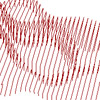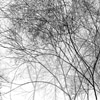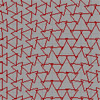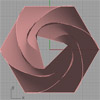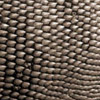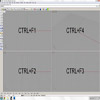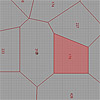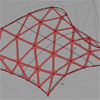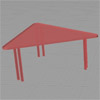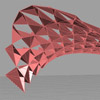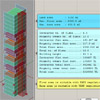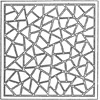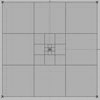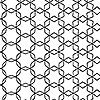Here is a funny sketching system for the “SPEC” homework. [GHX: 0.8.0066] Four (or more) points are created using 2d sliders (MD slider) and decomposed these points into x,y and z numbers. Then, they are re-populated in 3d points by changing their plane. X coordinates are connected into Y, and Y coordinates are connected to Z’s. Tricky part comes then, the X number is defined by a serie of numbers started from […]
February 2012
Today, we’ve studied ways of representing multiple data structures in Grasshopper. As of our last week’s experience, sometimes (most of the time actually) we’ll need to work with vast amount of data. We’ll have to control them in order to open door for further explorations. Today’s exercise was a good example of this “sustainable” process of data management. All functionality of Grasshopper is based on data matching. From short-list, long-list […]
This is the basic definition of one point attractor on a grid of points. [GHX: 0.8.0066] Here, the fundamentals of data tree matching can be studied. A hexagonal grid is exploded into points and new polygons are created there. Instead of a standard point distance relation to polygon size, this time the distance factor affects the rotational angle of these polygons. Although the structure of data trees is getting complicated, this has no […]
Maybe a huge kitsch for contemporary architecture, I know, but a good example of a fundamental problem of constructing geometric relationships. In ARCH362 today, we’ve examined the geometric modeling process that opens us to parametric relationships just by converting it into a diagram of design history. You may follow the construction of such a diagram step by step and see the possible parameters emerge from it. The only rule of […]
Whenever we try to define something suitable for our design intentions, it became somehow closely related to the design tool. The contemporary theory of computational design (or design computing) has many definitions. In this website, we look at that from the perspective of method and its theory underneath, not the tools; however, it finally comes to a point that we -again- start to talk about “tools”. Whatever, the purpose is […]
Here are some of the results of first assignment, “Reptile Skin”. Generally, we couldn’t manage to develop innovative solutions to the problem. But this became a good starting point for understanding the method of “skins of components” in contemporary digital design. Before going into any control over the flow of data, it’s hard to maintain associative geometries. We usually feel stuck within the capabilities of the single commands or procedures. […]
In recent years, computational approaches in architecture started to change the scope of the architect’s work. He/she is not any more a passive tool user instead, became a casual tool developer. Conventional CAD systems that focus on geometric representation of a designed artifact, are transforming into systems in which the design is represented as a parametric process. By increasing utilization of these systems in architectural design process, parametric modeling is integrated not only as a new medium of design representation, […]
Here are three technical tips, that might help you model in Rhinoceros faster. Please note that, in most cases, you’ll find CTRL+F1,F2,F3 and F4 very helpful in modeling and transforming objects in digital space. These key combinations will focus you on Top, Front, Left and Perspective views (maximized) respectively. Also, when you try to express your design process (especially supporting geometries) using different linetypes, it’s possible that you’ll never like those preset linetypes. By […]
That was about six months ago, our study for a design competition required a spatial allocation algorithm. An office building with a rectangular plot and a strict functional requirement forced me to the good old Voronoi diagrams, subdividing a surface. Here is the definition file: [GHX: 0.8.0066]. However, there were other design parameters such as the sunlight and orientations of each functional cell. Combining a couple of graph components helped me […]
This is the old-method Parametric Truss definition. Interestingly this quickly became a solid solution, used and taught for years. I couldn’t find a better answer yet. As Grasshopper updates, some of the components in this definition change but the overall structure remains. Subdivision of a free-form surface and addition of geometric components has, of course, a wide range of alternatives. Maybe we should combine this with different problems and solutions […]
[GHX:0.8.0066] This is a rather traditional geometry exercise we used to make in MaxScript. Grasshopper is also quite capable of associative geometry and real-time parametric designs of objects. The exercise of designing a furniture family should be based on design research, followed by shape alternatives and sketches (both digital and hand), then might be finalized using this parametric design environment. However, the example presented here is one of the most simplistic […]
In this experiment, I’m trying to use data recorder to change components on a surface. The component part is a standart triangular construction, but the attractor points are defined by a 2D slider that is connected to a data recorder. Data recorder remembers last 15 points, while you move the 2d slider, last 15 points are projected on the base surface. This creates an illusion as if a “snake” game […]
At the initial design phase of an apartment project in İstanbul, Nilüfer Kozikoğlu (TUŞPA Architecture) has offered me a job I haven’t done in Grasshopper before. This definition includes a sketch of a possible apartment renewal, analyzing and optimizing data from the contractor’s and property owners’ perspective. It also checks if the proposed solution is appropriate according to the building regulations for that area. In Turkish, KAKS means the maximum […]
The design of Chinese window lattices named “ice-ray” is one of the classic studies of Shape Grammars. It is an old and good example of algorithmic design. George Stiny explained their geometric construction based on the parametric Shape Grammars approach. He explained shape rules and the abstract machine that produces the subdivisions. I was especially interested in Shape Grammars when I was a graduate student. I even made a prototype […]
In order to start creating recursive algorithms in Grasshopper, I finally managed to run Hoopsnake, a special component developed by Yiannis Chatzikonstantinou. This will help me develop parametric models that include loops. The fundamental experiment here shows a surface subdivision based on iterations. We should define a starting object or data, an operation to be repeated, and a limit that will tell Hoopsnake to stop looping. In this condition, this […]
This is another starting point for pattern generation study in a dataflow environment. I tried to implement the parquet deformation of Islamic patterns in Grasshopper. I studied Hankin’s method of Islamic Pattern generation. Then I tried to simulate his process beginning with basic regular tiling (regular hexagonal tessellation). Craig S. Kaplan (here) explains this and other methods in his dissertation. A Simple Foundation We have already experienced the result of […]

